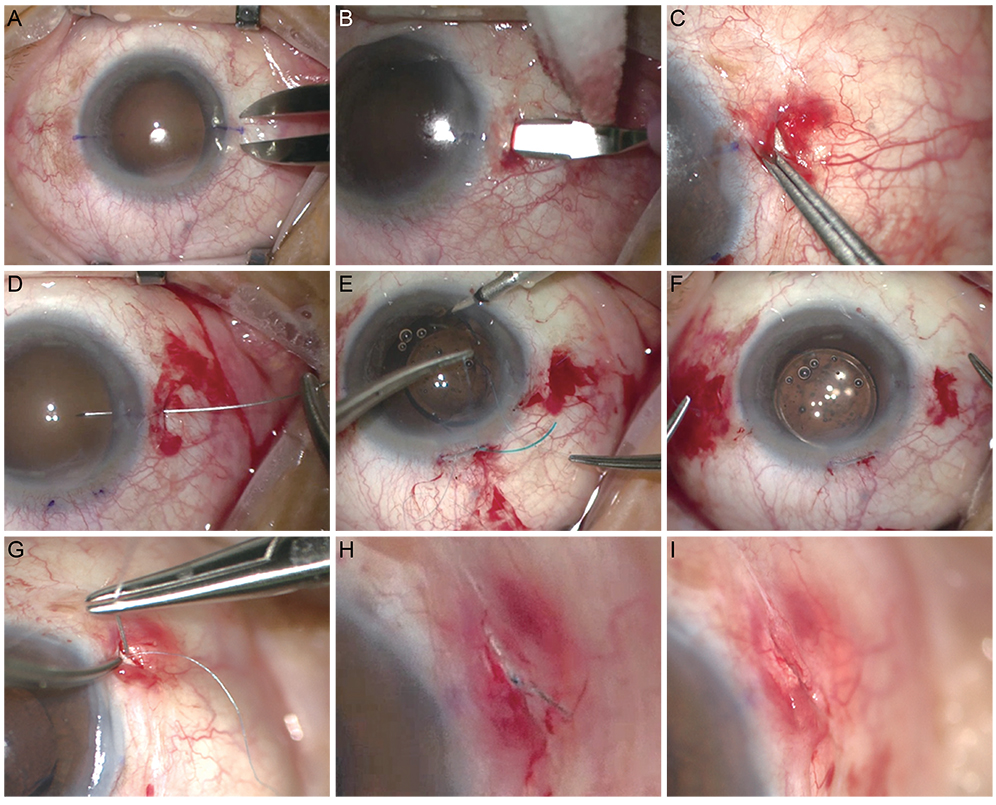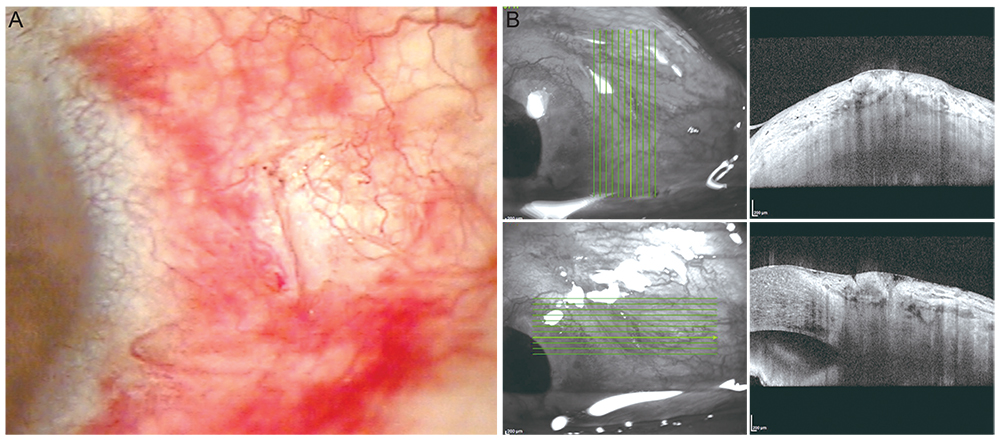Korean J Ophthalmol.
2014 Apr;28(2):181-185. 10.3341/kjo.2014.28.2.181.
Sutureless Intrascleral Pocket Technique of Transscleral Fixation of Intraocular Lens in Previous Vitrectomized Eyes
- Affiliations
-
- 1Department of Ophthalmology, Gyeongsang National University College of Medicine, Jinju, Korea. maya12kim@naver.com
- 2Gyeongsang Institute of Health Science, Gyeongsang National University, Jinju, Korea.
- KMID: 1792114
- DOI: http://doi.org/10.3341/kjo.2014.28.2.181
Abstract
- In this case series, we assessed a new technique, the intrascleral pocket procedure of transscleral fixation (TF) of the intraocular lens (IOL) in post-vitrectomized eyes. We performed the transscleral fixation of IOL in four aphakic patients who underwent pars plana vitrectomy. Two points 180degrees apart were marked at the limbus. A 2-mm-sized intrascleral pocket was created by lamellar dissection using a crescent blade without conjunctival dissection. A 2.8-mm clear corneal incision (CCI) was made using a keratome. Prolene sutures were exteriorized through the CCI pocket and a three-piece foldable acrylic IOL was injected via CCI and the ends of the haptics were exteriorized through the CCI. The prolene sutures for each haptic in the intrascleral pocket bed were then tied and knots were buried under scleral flaps. No patient had complaints such as conjunctival irritation, and visual acuity was almost identical to preoperative best-corrected visual acuity at day 1 postoperatively. IOLs were well placed without tilting or subluxation. They had no wound dehiscence or endophthalmitis postoperatively. The intrascleral pocket procedure of TF without the need for conjunctival dissection is a successful method for sulcus fixation in post-vitrectomized eyes predisposed to developing glaucoma.
MeSH Terms
Figure
Reference
-
1. Wagoner MD, Cox TA, Ariyasu RG, et al. Intraocular lens implantation in the absence of capsular support: a report by the American Academy of Ophthalmology. Ophthalmology. 2003; 110:840–859.2. Lewis JS. Ab externo sulcus fixation. Ophthalmic Surg. 1991; 22:692–695.3. Teichmann KD. Pars plana fixation of posterior chamber intraocular lenses. Ophthalmic Surg. 1994; 25:549–553.4. Kim DH, Heo JW, Hwang SW, et al. Modified transscleral fixation using combined temporary haptic externalization and injector intraocular lens implantation. J Cataract Refract Surg. 2010; 36:707–711.5. Ma DJ, Kim MK, Wee WR. Knotless external fixation technique for posterior chamber intraocular lens transscleral fixation: a 5-case analysis. J Korean Ophthalmol Soc. 2012; 53:1609–1614.6. Lin CP, Tseng HY. Suture fixation technique for posterior chamber intraocular lenses. J Cataract Refract Surg. 2004; 30:1401–1404.7. Solomon K, Gussler JR, Gussler C, Van Meter WS. Incidence and management of complications of transsclerally sutured posterior chamber lenses. J Cataract Refract Surg. 1993; 19:488–493.8. Lewis JS. Sulcus fixation without flaps. Ophthalmology. 1993; 100:1346–1350.9. Kir E, Kocaturk T, Dayanir V, et al. Prevention of suture exposure in transscleral intraocular lens fixation: an original technique. Can J Ophthalmol. 2008; 43:707–711.10. Malbran ES, Malbran E Jr, Negri I. Lens guide suture for transport and fixation in secondary IOL implantation after intracapsular extraction. Int Ophthalmol. 1986; 9:151–160.11. Szurman P, Petermeier K, Aisenbrey S, et al. Z-suture: a new knotless technique for transscleral suture fixation of intraocular implants. Br J Ophthalmol. 2010; 94:167–169.12. Stewart MW, Landers MB 3rd. Transscleral intraocular lens fixation with a "homemade" needle and hook. J Cataract Refract Surg. 2006; 32:200–202.13. Joo J, Lee YK, Rho CR, et al. Transscleral fixation of intraocular lens using the triple cow-hitch method. J Korean Ophthalmol Soc. 2011; 52:1370–1376.14. Mannan R, Sinha R, Sharma N, et al. Intrascleral reverse pocket approach of transconjunctival transscleral sulcus fixation of intraocular lens in eyes with ocular trauma. Eye Contact Lens. 2011; 37:316–319.
- Full Text Links
- Actions
-
Cited
- CITED
-
- Close
- Share
- Similar articles
-
- Is This Really Sutureless Intrascleral Pocket Technique of Transscleral Fixation?
- A Clinical Study on Transscleral Fixation of Posterior Chamber Intraocular Lens in Complete Vitrectomized Eyes
- Short-term Clinical Outcomes after Transscleral Fixation Using the Intrascleral Pocket Technique: A Retrospective Cohort Study Analysis
- Comparison of Surgical Outcomes between Conventional Sutured Scleral Fixation and Flanged Intrascleral Intraocular Lens Fixation
- Clinical Outcomes of Intrascleral Fixation of Intraocular Lens Compared to Ciliary Sulcus Implantation and Transscleral Fixation



